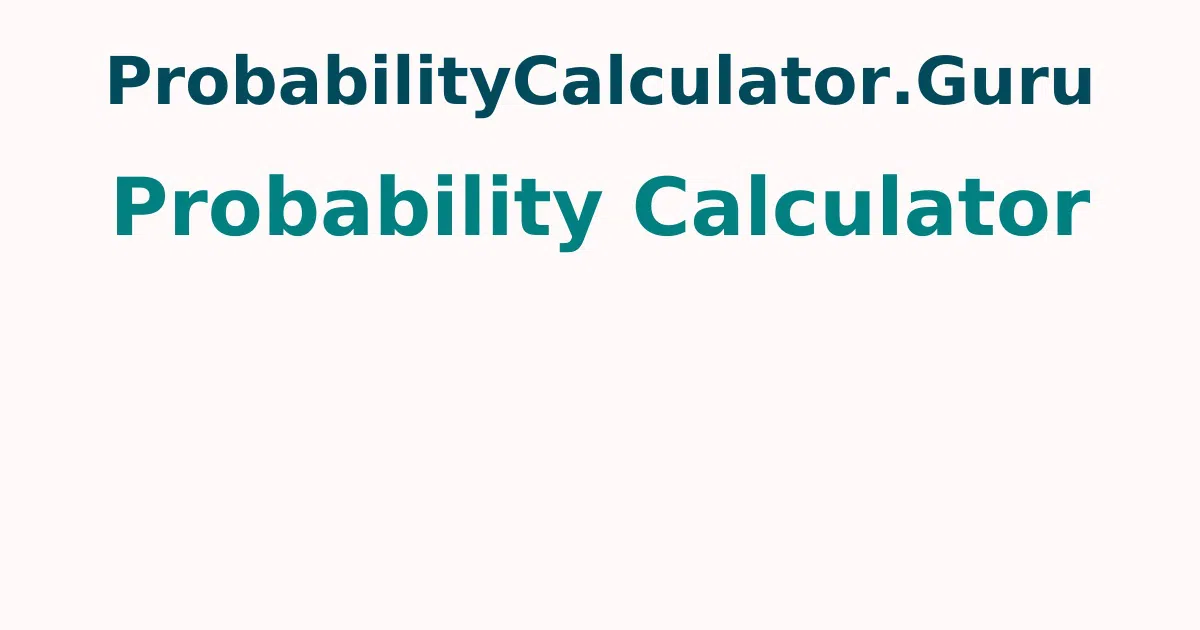Probability Calculator
Created By : Vaibhavi Kumari
Reviewed By : Rajashekhar Valipishetty
Last Updated : Apr 02, 2023
Probability Calculator helps you to compute the probability of one event occurring on the basis of probabilities of other events occurring. It takes favorable outcomes and total outcomes as inputs and displays the required output in seconds by clicking on the calculate button.
What is Meant by Probability in Maths ?
In mathematics, the probability is a field of statistics that is utilized to explain the likelihood of an event that is going to occur. A number that always lies between 0 and 1 is probability. When the probability value is equivalent to 1, then something will occur. If not, then something will never occur.
For instance, the probability of flipping a coin and its being tail is ½, because there is 1 way of getting a tail and the total number of possible outcomes is 2 (head or tail).
Types of Events That Influence Probability
There are three types of events that impact the probability outcome. They are:
- Independent
- Dependent
- Mutually exclusive
Basic Probability Formulas
The probability formula is the ratio of the number of ways an event can appear across the total number of possible outcomes. Thus, the formula can be written as
Probability of an event occurring = Number of ways an event can occur / Total number of possible outcomes.
A standard formula for the probability of an event to occur: P(A) = n(A) / n(S)
where,
- P(A) is the probability of an event happening
- n(A) is the number of ways an event can happen
- n(S) is the total number of possible outcomes
A standard formula for the probability of an event that will not occur: P(A') = 1 - P(A)
where,
- P(A') is the probability of an event cannot occur
- P(A) is the probability of an event occurring
How Do You Find The Probability Of An Event Manually ?
Here is the simple procedure that helps you find the probability of an event manually with ease. Take a look at the below steps:
- Firstly, we have to identify the number of favorable outcomes.
- Next, find the total number of outcomes.
- Now, utilize the basic formula of the probability of an event (ie., the number of favorable outcomes divided by the total number of outcomes.)
- Substitute the values in the probability formula and get the result effortlessly.
Get a good grip on all the concepts of probability by using Probabilitycalculator.guru provided online calculator tools.
Solved Example on Probability
Question:
If we toss a coin once, what is the probability of getting tails? Prove it using the probability calculator.
Solution:
Given favorable outcomes = 1
Total number of possible outcomes = 2
Probability of getting tails = 1/2 or 0.5
Therefore, the probability of getting tails is 0.5.
FAQs on Handy Tool of Probability Calculator with Steps
1. How do you calculate the probability?
By dividing the number of events that occurred by the number of possible outcomes gives us the probability of a single event happening. You can use multiple probability calculator, multiple events probability calculator, mutually exclusive probability calculator, possible outcomes calculator, online probability calculator, probability of simple events calculator, and probability calculator 4 events.
2. What are the formulas of single event probability?
The single event probability formulas are as follows:
- Probability of event A that occurs P(A) = n(A) / n(S).
- Probability of event A that does not occur P(A') = 1 - P(A).
3. What are the formulas of multiple event probability?
Probability calculator multiple events, probability of multiple events calculator, OR multiple event probability calculator. The following list will help you learn the multiple event probability formulas:
- P(A) = n(A) / n(S).
- P(A') = 1 - P(A).
- P(B) = n(B) / n(S).
- P(B') = 1 - P(B).
- The probability that both the events occur P(A ∩ B) = P(A) x P(B).
- Probability that either of event occurs P(A ∪ B) = P(A) + P(B) - P(A ∩ B).
- Conditional Probability P(A | B) = P(A ∩ B) / P(B).
4. How to find the probability of two events?
Simply by multiplying the probability first event with the second event, you can calculate the probability of two events. For instance, if the probability of event A is 8/2 and the probability of event B is 4/2 then the probability of two events occurring at the same time is (8/2)*(4/2) = 4 * 2 = 8.
